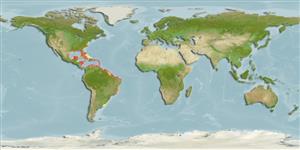Common names from other countries
>
Clupeiformes (Herrings) >
Dorosomatidae (Gizzard shads and sardinellas)
Etymology: Harengula: Old English haring, hering = mackerel, the fish Clupea harengus (Ref. 45335).
More on author: Poey.
Environment: milieu / climate zone / depth range / distribution range
Ecologie
marien; brak water rifbewoner; diepte ? - 22 m (Ref. 26912), usually 1 - 5 m (Ref. 40849). Tropical; 43°N - 37°S, 99°W - 33°W (Ref. 188)
Western Atlantic: New Jersey, USA and Bermuda southward to Florida (USA), Gulf of Mexico, Caribbean, and southern Brazil. Often confused with Harengula clupeola with which it co-occurs over most of its range.
Lengte bij maturiteit / Grootte / Gewicht / Leeftijd
Maturity: Lm 8.1, range 8 - 8.5 cm
Max length : 21.2 cm TL mannelijk / geslacht onbekend; (Ref. 5217); common length : 12.0 cm SL mannelijk / geslacht onbekend; (Ref. 188); max. gerapporteerde leeftijd: 3.00 Jaren (Ref. 12193)
Dorsale stekels (totaal): 0; Dorsale zachte stralen (totaal): 13-21; Anale stekels 0; Anale zachte stralen: 12 - 23. Tooth plate on tongue and tooth plate behind it (basihyal and basibranchial tooth plates) very broad, their width about 3 to 5 times in their combined length, the basihyal tooth plate with a very distinct bulge in front (Ref. 188). Scales fairly strongly attached, not easily lost (Ref. 188). No dark pigment on dorsal fin tip (Ref. 188). No orange or red spot at opercle. Belly deep, lower profile decidedly more curved than the flattened upper profile (Ref. 7251).
Occurs in coastal waters, over mud sand bottoms and frequently near brackish or hyper-saline estuaries (Ref. 5217). Forms schools. Marketed fresh or canned.
Juveniles of 2.9 to 4.4 cm SL appeared in Guanabara Bay, Rio de Janeiro, in May and migrated out in December or March at 7.5 to 8.0 cm.
Whitehead, P.J.P., 1985. FAO Species Catalogue. Vol. 7. Clupeoid fishes of the world (suborder Clupeoidei). An annotated and illustrated catalogue of the herrings, sardines, pilchards, sprats, shads, anchovies and wolf-herrings. FAO Fish. Synop. 125(7/1):1-303. Rome: FAO. (Ref. 188)
Status op de Rode Lijst van het IUCN (Ref. 130435)
CITES (Ref. 128078)
Not Evaluated
Gevaar voor de mens
Harmless
Gebruik door de mens
Visserij: van minder commercieel belang
Meer informatie
ReferentiesAquacultuurAquacultuurprofielKweeklijnenGeneticaElectrophoresesErfelijkheidZiektesVerwerkingMassaconversie
Tools
Speciale rapporten
Download XML
Internetbronnen
Estimates based on models
Preferred temperature (Ref.
115969): 23.2 - 28.1, mean 27.1 (based on 872 cells).
Fylogenetische diversiteitsindex (Ref.
82804): PD
50 = 0.5625 [Uniqueness, from 0.5 = low to 2.0 = high].
Bayesian length-weight: a=0.00912 (0.00784 - 0.01061), b=3.05 (3.01 - 3.09), in cm Total Length, based on LWR estimates for this species (Ref.
93245).
Trofisch niveau (Ref.
69278): 3.4 ±0.0 se; based on diet studies.
Weerstandsvermogen (Ref.
120179): Gemiddeld, minimale populatieverdubbelingstijd 1,4-4,4 jaar (K=0.48-0.60; tmax=3; Fec=5,000).
Fishing Vulnerability (Ref.
59153): Low vulnerability (21 of 100).
